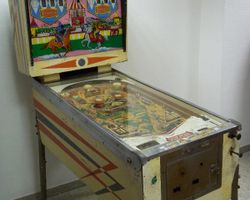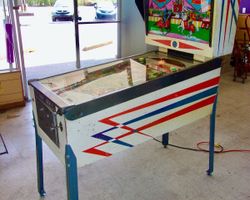Valiant

Average Prices: USD $300 to $900
Produced: August, 1962
Production Run: 1,050 units
Machine Type: Electro-mechanical
Players: 2
Design by: Steve Kordek
"Valiant," a compelling electro-mechanical (EM) pinball machine, emerged from the manufacturing facilities of Williams Electronic Games, Inc. in August 1962. With a production run of 1,050 units, this two-player game, model number 266, represented a distinctive offering in the early 1960s pinball landscape. Its creation involved the talents of design engineer Steve Kordek, a prolific figure in pinball's developmental years, and artist George Molentin, who rendered the machine's historical, knight-themed visuals. The collaborative effort aimed to craft an engaging experience that challenged players of the era, focusing on mechanical ingenuity and strategic play rather than intricate electronic programs. "Valiant" was conceived in a time when pinball was a staple in arcades, diners, and recreational spaces, demanding a balance between accessibility for casual players and depth for dedicated enthusiasts. Its release contributed to Williams' growing reputation as a company committed to pushing the boundaries of EM design. An interesting operator-selectable feature allowed for double match awards, offering two, five, or ten replays, indicating the machine's potential for sustained competitive play and its appeal as a revenue generator for operators.
Signature Features and Design
"Valiant" distinguishes itself through a set of features that underscore its design philosophy, prioritizing player interaction and skill. Foremost among these are its four flippers, a configuration that was notably less common at the time, particularly in the specific arrangement seen on this machine. These flippers are strategically placed, with a pair in the traditional lower position and another pair positioned higher up the playfield. This setup immediately broadens the shot selection and introduces distinct upper and lower playfield dynamics, demanding varied flipper skills.
Complementing the flipper arrangement are four kick-out holes distributed across the playfield. These mechanisms are central to scoring and progression, often collecting a ball and then ejecting it back into play, creating a distinct rhythm of play. Unlike simple static targets, the kick-out holes introduce an element of uncertainty and rapid ball return, compelling players to react quickly. Further enhancing the dynamic nature of the playfield are two swinging targets. These are not static hit-and-score targets; their movement adds an unpredictable element to aim, requiring precise timing and anticipation from the player. Beyond these primary features, "Valiant" incorporates two pop bumpers, three passive bumpers, two slingshots, and three rollover buttons, each contributing to the ball's movement and potential scoring opportunities.
Visually, George Molentin's artwork on "Valiant" embodies a historical theme centered around knights and medieval aesthetics. The backglass and playfield art depict scenes and characters consistent with this theme, aiming to immerse players in a bygone era of chivalry and valor. While the artistic execution has received varied feedback over time, the thematic consistency ties the visual presentation to the machine’s name and era. A practical consideration for collectors, however, is the backglass, which is known to be prone to flaking and peeling over time, a common challenge with materials used in that period.
Playfield and Mechanics
The playfield layout of "Valiant" is designed to create a challenging and engaging experience, making players "work for their score." The arrangement of its components encourages a methodical approach to gameplay, rather than relying on random shots. At the base of the playfield are the main two flippers, offering control over the lower half of the game. Above these, another set of two flippers opens up opportunities for shots into the upper reaches of the playfield. This dual-flipper setup dictates much of the game's flow, as players must master shots from both lower and upper perspectives.
Strategically placed around the playfield are the four kick-out holes. Their locations require deliberate shots to activate, often from specific flippers or after navigating certain lanes. Once a ball enters a kick-out hole, it awards points and is then powerfully ejected, frequently returning to the lower playfield for another attempt or setting up a different shot. This constant cycling through kick-out objectives forms a core part of the gameplay loop.
The three rollover buttons, offering 100 points each, are positioned strategically, particularly under the upper flippers. Reaching these rollovers often requires precise shots and careful control, establishing them as challenging objectives that reward accuracy. Two swinging targets provide dynamic scoring opportunities; hitting them accurately while they are in motion demands timing and a keen eye. The playfield also features two pop bumpers, which add chaotic, unpredictable deflections to the ball's path, and three passive bumpers and two slingshots, which redirect the ball and keep it in motion, preventing it from draining too quickly. The overall design philosophy emphasizes controlled shot-making and strategic awareness over mere luck. The artwork, while debated in its artistic merit, contributes to the overall aesthetic with its knightly motifs and contributes to the machine's distinct identity within the Williams EM catalog.
Gameplay Dynamics
"Valiant" presents a gameplay experience centered on skill, precision, and sustained ball control. The scoring system is straightforward, with a maximum displayable score of 1,999 points per player, characteristic of EM machines of its era. Players primarily accumulate points by hitting targets, triggering kick-out holes, and activating rollover buttons. The 100-point rollover buttons, particularly those situated under the upper flippers, serve as a notable challenge, demanding precise aiming and a nuanced understanding of ball trajectory. Successfully hitting these targets is a testament to a player's mastery of the playfield's upper regions.
The game's progression is largely driven by activating the four kick-out holes. While specific modes in the modern sense are absent, hitting these holes repeatedly or in sequence can contribute significantly to a high score. The two swinging targets introduce a layer of timing-based play; hitting them requires not just aim but also an understanding of their movement pattern. The challenge lies in consistent execution across the playfield, utilizing all four flippers to navigate the various scoring opportunities.
"Valiant" is designed to be a challenging game, where high scores are earned through concerted effort. This emphasis on player skill is reinforced by its replay system. Operators could set replay levels at points like 1100, 1300, 1500, and 1700, indicating that reaching these thresholds was considered an achievement worthy of additional gameplay. Furthermore, the operator-selectable double match award, offering 10 replays for a 2-player match, highlights the machine's capacity to encourage competitive play and extended sessions, fostering a dynamic where players strive for repeated success rather than fleeting high scores. The game's enduring appeal for some players stems from this demanding yet rewarding gameplay loop.
Reception and Legacy
"Valiant" elicits a range of opinions within the pinball community, reflecting its strengths and perceived weaknesses. Enthusiasts often praise its engaging and challenging gameplay. The machine demands a player's full attention, compelling them to "work for their score" rather than relying on luck. The four-flipper layout, particularly for an early 1960s EM, is frequently cited as a unique and compelling feature that offers varied shot angles and requires adaptability. The presence of four kick-out holes and two swinging targets also contributes to its distinct play experience, making it stand out from more conventional designs of the period. For some, the machine has provided "decades of fun," a testament to its enduring playability and its capacity to engage across generations. Its inherent replay potential, with customizable replay settings, further underscores its appeal as a competitive and rewarding machine. For collectors, it can occasionally present itself as a "good garage sale find," offering a valuable piece of pinball history.
However, "Valiant" is not universally acclaimed. Feedback on its artistic design, particularly the backglass and playfield art, is mixed; some do not consider it among the more aesthetically pleasing machines of its era. This subjective evaluation of its visuals can impact its overall perception for collectors who prioritize artistic presentation. Additionally, while many appreciate its challenge, some players have found its gameplay to be less captivating, even describing it as "boring," indicating that its demanding nature may not appeal to all playstyles. A practical concern for owners is the vulnerability of the backglass to flaking and peeling, a common issue with materials from that period that necessitates careful preservation.
Despite these varied opinions, "Valiant" holds a place in pinball history as a representative Williams EM from a pivotal developmental period. Its designer, Steve Kordek, continued to influence pinball design for decades, and "Valiant" exemplifies some of the early experimentation with multi-flipper layouts and complex shot geometry that would later become more common. Its unique blend of challenging mechanics and a distinct playfield layout has ensured its survival in collector circles, where it is appreciated for its historical significance and its capacity to provide a pure, skill-based pinball experience, showcasing the mechanical ingenuity of its time.
Sponsored Links
 Ebay Listings
Ebay Listings
 Auction Results
Auction Results
| Cost | Location | Date |
|---|---|---|
| EUR €850 |  Nordrhein-Westfalen, Germany Nordrhein-Westfalen, Germany |
21 September, 2025 |
| EUR €850 |  Nordrhein-Westfalen, Germany Nordrhein-Westfalen, Germany |
26 June, 2025 |
| USD $990 |  Tennessee, United States Tennessee, United States |
26 April, 2022 |
| USD $900 |  Illinois, United States Illinois, United States |
13 February, 2022 |
| EUR €700 |  Hessen, Germany Hessen, Germany |
12 December, 2021 |
| USD $475 |  Minnesota, United States Minnesota, United States |
16 August, 2021 |
| GBP £475 |  United Kingdom United Kingdom |
08 May, 2019 |
| USD $143 |  Missouri, United States Missouri, United States |
11 January, 2016 |
| GBP £350 |  Mitchell, United Kingdom Mitchell, United Kingdom |
30 August, 2015 |
| USD $255 |  New Hampshire, United States New Hampshire, United States |
21 November, 2011 |


Private Policy · Search Website · Contact Us
As an eBay Partner, we may earn a commission from qualifying purchases made through links on this site, at no additional cost to you.
All trademarks and copyrighted materials remain property of their respective owners. All other content copyright 2007 - 2025 Pinpedia.







